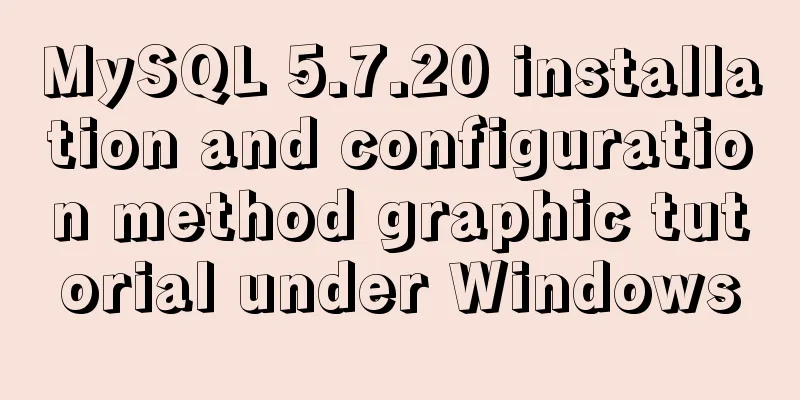How to install and configure MySQL 8.0.12 decompressed version under Windows 10 with graphic tutorials

|
This article records the installation and configuration methods of the decompressed version of MySQL 8.0.12 and shares them with everyone. Installation environment: Window10 Home Edition, 64-bit Database: MySQL 8.0.12 64-bit Installation method: Compressed package installation Installation steps: 1. Download the installation package Download the latest installation package from the MySQL official website Simply click "No thanks, just start my download." at the bottom to start downloading the compressed package after the successful download.
Note: When installing the database, the logged-in user must have Administrator privileges. 2. Unzip the compressed package and put it in the directory to be installed The file structure after decompression is as follows:
From the unzipped file structure, we can see that there is no my.ini configuration file in it, so we need to create the my.ini configuration file ourselves. 3. Create the my.ini configuration file # Database server configuration items [mysqld] # Database path basedir=D:\\Programs\\MySQL\\MySQL-8.0.12-winx64 #Data path datadir=D:\\Programs\\MySQL\\data #Port number port=3306 # Default character set character-set-server=utf8mb4 # Storage engine default-storage-engine=INNODB # Client configuration items [mysql] #Default character set default-character-set=utf8mb4 #Connection client configuration item [client] default-character-set=utf8mb4 After the configuration file is created, you can proceed to the next step of installation. 4. Initialize MySQL using operation instructions Open the terminal and go to the bin directory under the data installation path:
Enter the command "mysqld –initialize –console" in the terminal and press Enter to complete the initialization:
Note: After the initialization is completed, do not close the window, because the password of the root user will be generated here. The "p=brffHdg4T5" in the figure is the random password. Of course, there is another initialization method that does not generate a random password, but you still need to set a password before officially using the database. The initialization command is "mysqld –initialize-insecure –console". When the database is initialized without a random password, you need to use " mysql -u root --skip-password" when logging in for the first time, that is, skip the password verification method to log in. 5. Database service installation After the database is initialized, you can register the data as a Windows service, so that you can start the database as a service. Open the terminal and go to the bin directory under the data installation path, as shown in Figure 1 in step 4. Use the command "mysqld –install" to complete the installation of the service:
Note: When registering the service, be sure to use administrator privileges, otherwise the installation of the service will be rejected. At the same time, you can also use the command "mysqld –remove" to remove the registered service. In fact, the complete command for registering a service is “mysqld –install service name”. If the service name is not written, the default is “MySQL”. The service removal command is also “mysqld –remove service name”, and the default value is “MySQL”. 6. Service startup Use the command "NET start MySQL" in the terminal to start the database service:
Verify that the service has been started. Try to log in to the database on the terminal page. The password you need to enter here is the random password generated by the system during initialization in step 4 Figure 2. Just enter it:
Login successful! Before executing the command, the system will force you to change the random password used during initialization:
Use the command "ALTER USER 'root'@'localhost' IDENTIFIED BY 'my_new_psd';" and press Enter:
After changing the password, you can use the database normally!
Use the client tool to connect to the database:
The above is the full content of this article. I hope it will be helpful for everyone’s study. I also hope that everyone will support 123WORDPRESS.COM. You may also be interested in:
|
<<: Zookeeper stand-alone environment and cluster environment construction
>>: Mini Program to Implement Simple List Function
Recommend
W3C Tutorial (7): W3C XSL Activities
A style sheet describes how a document should be ...
How to add abort function to promise in JS
Table of contents Overview Promise Race Method Re...
Method of implementing recursive components based on Vue technology
describe This article introduces a method to impl...
Tomcat CentOS installation process diagram
Tomcat CentOS Installation This installation tuto...
MariaDB under Linux starts with the root user (recommended)
Recently, due to the need to test security produc...
Example of how to achieve ceiling effect using WeChat applet
Table of contents 1. Implementation 2. Problems 3...
harborRestart operation after modifying the configuration file
I won't say much nonsense, let's just loo...
Summary of basic usage of $ symbol in Linux
Linux version: CentOS 7 [root@azfdbdfsdf230lqdg1b...
Use js in html to get the local system time
Copy code The code is as follows: <div id=&quo...
Correct way to load fonts in Vue.js
Table of contents Declare fonts with font-face co...
Detailed explanation of the idea of setting up login verification interception function in Vue
Table of contents 1. Solution 2. Let the browser ...
MySQL 5.7 installation and configuration method graphic tutorial
This tutorial shares the installation and configu...
Solve the pitfall of storing boolean type values in localstorage
LocalStorage stores Boolean values Today, when I ...
W3C Tutorial (2): W3C Programs
The W3C standardization process is divided into 7...
Solve the problem of being unable to log in when installing MySQL on mac using homebrew
If your computer is a Mac, using homebrew to inst...




















